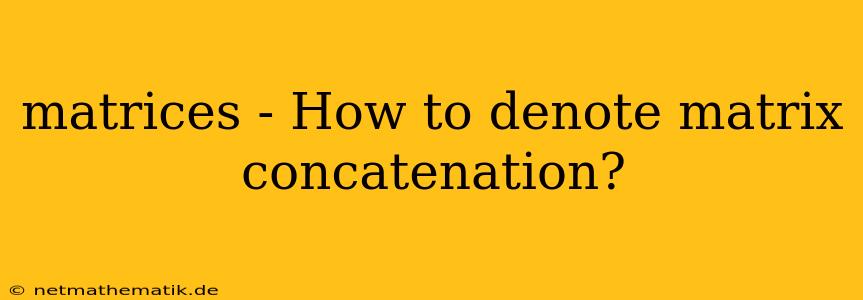Matrices are fundamental mathematical objects that are used to represent and manipulate data in a variety of fields, including linear algebra, computer science, and statistics. One common operation performed on matrices is concatenation, which involves combining two or more matrices into a single, larger matrix. This article will delve into the nuances of matrix concatenation, exploring its different types, notation conventions, and practical applications.
Understanding Matrix Concatenation
Matrix concatenation refers to the process of joining two or more matrices together to create a new matrix. It's analogous to concatenating strings in programming, where you combine multiple strings into a single, longer string. The resulting concatenated matrix retains the properties of the original matrices, including the dimensions and the arrangement of elements.
There are two main types of matrix concatenation:
Horizontal Concatenation:
Horizontal concatenation involves combining matrices side-by-side. The number of rows in all matrices being concatenated must be equal. The resulting matrix will have the same number of rows as the original matrices and a number of columns equal to the sum of the columns of the original matrices.
Vertical Concatenation:
Vertical concatenation involves stacking matrices on top of each other. The number of columns in all matrices being concatenated must be equal. The resulting matrix will have the same number of columns as the original matrices and a number of rows equal to the sum of the rows of the original matrices.
Denoting Matrix Concatenation: A Comprehensive Guide
The notation for matrix concatenation varies depending on the context and the specific type of concatenation being performed. Here are some common notations:
1. Using Brackets and Commas:
- Horizontal Concatenation: [A, B] represents the horizontal concatenation of matrices A and B.
- Vertical Concatenation: [A; B] represents the vertical concatenation of matrices A and B.
2. Using the cat Function (MATLAB):
In MATLAB, the cat function is used for concatenating matrices. For example, cat(2, A, B) performs horizontal concatenation of matrices A and B, while cat(1, A, B) performs vertical concatenation.
3. Using the hstack and vstack Functions (NumPy):
In NumPy, the hstack and vstack functions are used for horizontal and vertical concatenation respectively.
4. Using the concatenate Function (NumPy):
The concatenate function in NumPy offers more flexibility for matrix concatenation. You can specify the axis along which you want to concatenate the matrices:
concatenate((A, B), axis=0)for vertical concatenation.concatenate((A, B), axis=1)for horizontal concatenation.
Illustrative Examples:
Let's look at some examples to solidify the understanding of matrix concatenation:
Example 1:
Suppose we have two matrices:
A = [1 2]
[3 4]
B = [5 6]
[7 8]
-
Horizontal Concatenation: [A, B] = [1 2 5 6] [3 4 7 8]
-
Vertical Concatenation: [A; B] = [1 2] [3 4] [5 6] [7 8]
Example 2:
Suppose we have three matrices:
C = [1 2]
[3 4]
D = [5 6]
E = [7 8]
[9 10]
-
Horizontal Concatenation: [C, D, E] = [1 2 5 7 8] [3 4 6 9 10]
-
Vertical Concatenation: [C; D; E] = [1 2] [3 4] [5 6] [7 8] [9 10]
Applications of Matrix Concatenation:
Matrix concatenation is a fundamental operation with wide applications across various domains:
1. Image Processing:
Concatenation plays a crucial role in combining images, especially when dealing with image stitching or creating panoramas.
2. Data Analysis:
In data analysis, concatenation is used to combine datasets, allowing for a more comprehensive view of the data. It's also used in machine learning for preparing data for training and testing models.
3. Computer Graphics:
Concatenation is essential for manipulating objects in 3D graphics, including transformations like translation, rotation, and scaling.
4. Linear Algebra:
In linear algebra, concatenation is employed for constructing block matrices, which are matrices formed by partitioning and then combining smaller matrices.
Conclusion:
Understanding matrix concatenation is essential for effectively working with matrices, especially in domains that heavily rely on linear algebra and data manipulation. By grasping the different notations, types, and applications of matrix concatenation, you can effectively combine matrices and leverage their power to address various computational challenges. As you continue your journey into the world of mathematics and computer science, remember that the ability to concatenate matrices is a valuable tool that empowers you to work with complex data structures and solve complex problems.
